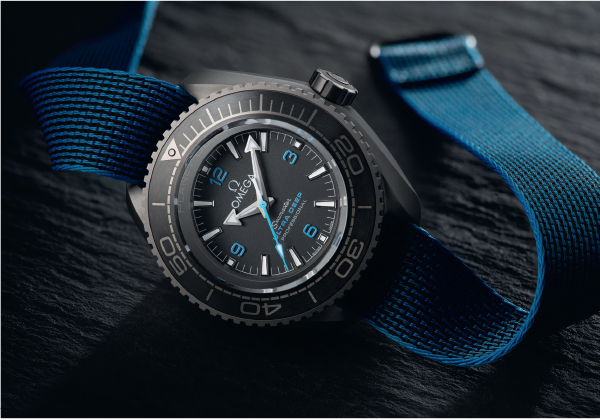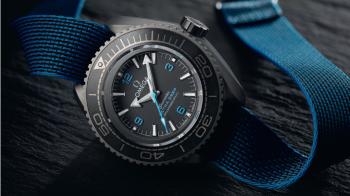Omega has a long history of dive watches, and understanding the Ultra Deep involves getting a feel for these historic roots. Indeed, Omega’s diving credentials now stretch back 90 years. Developed in 1932, the Omega Marine accompanied US explorer and inventor of the bathysphere Charles William Beebe on what was at that time a record-breaking dive of 14 metres! Next came the first Seamaster in 1948. The professional version, the Seamaster 300, was tested to a depth of 300 metres in 1957, followed in 1970 by the legendary Ploprof, doubling the water resistance depth to 600 metres and tested to a depth of 1,000 metres. Five years later came a more wearable version, the appropriately-named Seamaster 1000.
A long gap of 35 years followed, mainly due to the quartz crisis, but also to the fact that Omega was by this time set on multiplying its depth record tenfold rather than merely doubling it — and going from 1,000 to 10,000 metres was not a piece of cake. At that depth, the pressure is one tonne per square centimetre.

Almost 11,000 Metres Down
And so to depths that are the preferred domain of the Planet Ocean and its even more extreme version, the Planet Ocean Ultra Deep. In 2005, the Planet Ocean focused on being water-resistant to 600 metres; the next episode saw the re-release of the Ploprof, water-resistant to 1,200 metres. Keen to go deeper still, a few years later in 2019 Omega embarked on a partnership with explorer Victor Vescovo for a mission to the bottom of the Marianas Trench in the Pacific Ocean. The originally measured depth of 10,925 metres has since been revised to 10,935m. Could a watch survive at such extreme depths? The Seamaster Planet Ocean Ultra Deep, a concept watch, demonstrated that one could.
Omega sent three of these Ultra Deep proof-of-concept timepieces down on the expedition: two of them were secured to the robotic arm of Victor Vescovo’s submersible, while the other was attached to a data collection unit known as a ‘lander’. Thanks to their ingenious design and construction, the three watches completed the 12-hour dive without a hitch and returned unscathed to the surface.
Ultra deep- and wearable
Three years after that, Omega decided to market a more wearable version for the general public. There could be no question of replicating the three concept watches: there was simply no point in releasing a watch water-resistant to almost 11,000 metres, besides which they were the size of a hockey puck, making them both unwearable and unsellable. Instead, Omega offered a watch water-resistant to a depth ten times that of the standard Planet Ocean’s 600 metres: the new Ultra Deep, water-resistant to 6,000 metres. As of 2022, seven different versions are available in the catalogue.
Alongside versions in O-Megasteel, the direct descendant of this expedition is made of grade 5 titanium and has a diameter of 45.5 millimetres. The body of the bezel, the frame, the caseback, and the crown are also all made of titanium; the corresponding components of the concept watch were made from off-cuts from the titanium hull of the submersible used for the 10,935-metre dive. Omega added its celebrated satin-finish bezel featuring a Liquidmetal™ diving scale, its distinctive manta ray lugs, and an asymmetric case bringing to mind the original Ultra Deep. The new Ultra Deep is teamed with a NATO strap made from 100% recycled fishing nets, secured with a buckle and loops made from grade 5 titanium.
Ultra Deep, mais portable
Trois ans plus tard, Omega décide de commercialiser une version grand public, plus portable. Il ne s’agit pas de reprendre à l’identique les trois montres concept: proposer une pièce étanche à près de 11000 mètres n’a aucun sens, et sa dimension de la taille d’un puck l’aurait rendue importable, donc invendable. Omega propose donc une pièce 10 fois plus résistante que la Planet Ocean principale (600 mètres): ce sera la nouvelle Ultra Deep (6000 mètres). Il en existe, au catalogue 2022, sept versions différentes.
Aux côtés de versions en acier O-Megasteel, la descendante directe de cette expédition est en titane grade 5 et affiche un diamètre de 45,5mm. Le corps de la lunette, la carrure, le fond du boîtier et la couronne sont tous façonnés dans du titane également — la concept watch voyait ces éléments faits des chutes du titane utilisé pour la coque du submersible de l’expédition à 10935 mètres. Omega y implante sa fameuse lunette en céramique satinée avec une échelle de plongée en Liquidmetal™, ainsi que les cornes intégrées «manta » distinctives et le boîtier asymétrique qui rappellent l’Ultra Deep originale. Cette nouvelle Ultra Deep repose sur un bracelet NATO provenant de filets de pêche 100% recyclés, fermé par une boucle et un passant en titane grade 5.
This year GMT Magazine and WorldTempus have embarked on the ambitious project of summarising the divers watch since 2000 in The Millennium Watch Book - Divers watch, a big, beautifully laid out coffee table book. This article is an extract. The Millennium Watch Book - Divers watch is available in both French and English here:





